MARKET OVERVIEW
The global frozen soup market is a distinctive niche in the convenience foods market, defining its character through innovation, shifting lifestyles, and new consumer demands. While sometimes observed from the perspective of product assortment or local consumption patterns, the market possesses a greater meaning that goes beyond everyday consumption habits. Over the next few years, the sector will not merely serve convenience; it will gradually integrate itself into a broader narrative that includes sustainability, changing retail patterns, and food preservation technology.
With more and more urban lifestyles confined to a time crunch, demand for ready-to-eat or easily preparable meals will continue to grow. Yet the global frozen soup market is not merely bowing to this need. It is on the brink of establishing a precedent regarding the way frozen foods can provide nutrition as well as comfort, particularly in cultures where home cooking is in the process of being supplanted by packaged options. These soups will become more and more symbols of nourishment and nostalgia forgotten flavors from across the globe, ready to be reconstituted in microwave-safe bowls.
Among the most important of these developments will be its tie to ethical production and clean labeling. As people become increasingly aware of what they are putting into their bodies, frozen soup is going to come under new scrutiny. Companies will need to cut artificial additives from their products and develop options that are sodium-free or preservative-free. This will open up a change in the supply chain, where ingredients locally sourced and transparent sourcing strategy will become crucial. The industry will evolve, discovering new means of conveying soups that not only taste new but are also resilient enough to meet rising ethical standards.
The growth of global cold chain logistics will redefine the horizon of the global frozen soup market as well. That which was once a luxury reserved for specific geographies will soon make its way into regions where frozen food choices were scant or non-existent. As freezer technology advances and becomes more available in rural and underdeveloped regions, the industry will find hidden demand. It will be in these uncovered territories that the next phase of growth will go about its business quietly, delivering convenience to families that were previously out of reach.
Digital transformation will further change how frozen soups are bought and consumed. As e-commerce and food delivery apps continue to grow, the frozen food section will no longer be relegated to grocery store shelves. Direct-to-consumer business models will become more popular, providing customized soup subscriptions or carefully curated meal kits featuring frozen soup selections. The package will be the focal point, not just for maintaining quality but also in communicating a brand message to environmentally aware consumers.
Eventually, the global frozen soup market will move beyond being simply another convenience food category. It will embody sweeping cultural trends, sustainability initiatives, and advances in food storage and delivery technology. As it evolves to keep pace with shifting consumer values, regulatory systems, and global trade dynamics, the market will cut out a future that's much more energetic than its frozen nature might lead us to believe.
Global frozen soup market is estimated to reach $231.7 Million by 2032; growing at a CAGR of 6.2% from 2025 to 2032.
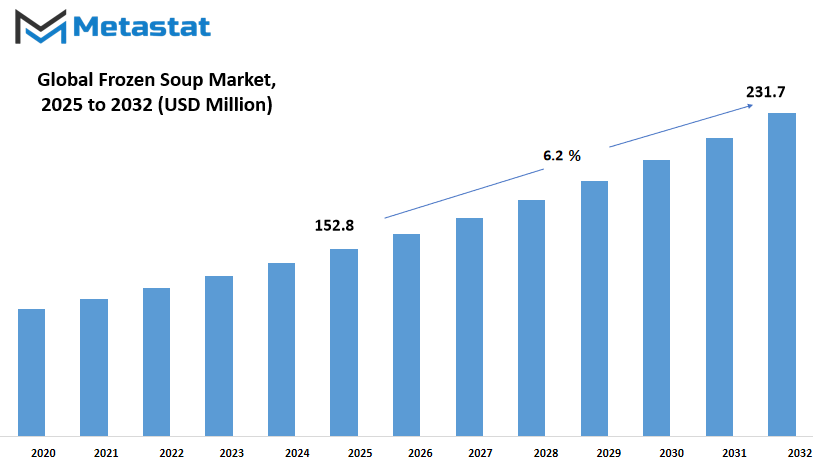
GROWTH FACTORS
The global frozen soup market is becoming increasingly popular as more consumers seek out meal alternatives that are easy and quick to prepare. Busy lifestyles and work schedules do not allow a lot of people to cook from scratch daily. Frozen soups provide an efficient solution by presenting prepared meals that do not take much effort. Customers can heat and serve them in minutes and thus are best suited for lunchtime or evening after a busy day. This increasing demand for convenience has been a key driver of the market, particularly in city centers where time is short.
A 2d full-size cause of the growth of the market is the extended enthusiasm for wholesome eating. Most firms now provide frozen soups that comprise natural be counted, lower salt content, and no synthetic preservatives. Such options attract fitness-conscious customers who desire brief meals without compromising on vitamins. Consumers are getting increasingly more sensitive to the composition of food, and this has triggered manufacturers to provide merchandise which can be healthy and delicious. The alternatives of vegetarian, vegan, gluten-unfastened, and low-calorie picks have even further extended the attraction so frozen soup can accommodate a lot of diets.
Even so, the global frozen soup market has a few challenges. One of the maximum pervasive customer ideals is that frozen meals isn't as fresh or as healthful as though it were homemade or freshly organized. This perception can placed certain purchasers off from opting for frozen soup, even if made with precise ingredients. There is likewise harsh competition from other comfort food segments such as ready-to-devour salads, meal kits, and the fast-growing fresh food transport offerings. These merchandise generally tend to market themselves as more energizing or extra gourmet, that may divert the clients' interest away from frozen services.
In spite of those issues, there's capacity for the global frozen soup market to enlarge with intelligent innovations. New packaging forms that keep soups for extended intervals even as lowering the environmental effect are in the making. Companies are also getting into the international flavor and worldwide delicacies-based totally soups phase, which appeals to food fanatics who crave range. Introducing healthy-centric recipes and boosting visible enchantment with revolutionary packaging facilitates agencies entice new and repeat customers.
In future years, the enterprise is in all likelihood to enjoy the gain of extended adjustments in purchasers' behavior and consuming behavior. As manufacturers keep to strike a stability among fitness and convenience, tasty and healthy frozen soups are likely to get greater attention. Those brands that invest in pleasant, health, and deliberate packaging stand a greater likelihood of standing out on this crowded, competitive marketplace.
MARKET SEGMENTATION
By Type
The global frozen soup market is present process a regular but slow trade, prompted by using shifting life and increasing demand for convenience. Today's consumers are searching out simple-to-prepare meals without sacrificing flavor or vitamins. Frozen soups fill this requirement pretty well they are easy to warmth and serve, saving time with out sacrificing range or comfort. With increasing purchasers choosing geared up-made ingredients to healthy their anxious way of life, frozen soups are a commonplace sight on family tables in diverse areas.
The enterprise is divided into numerous sorts, each serving distinctive tastes and nutritional choices. Classic Frozen Soup, offering a cost of $19.2 million currently, nevertheless maintains its customer base who select the comforting taste of traditional recipes. These sorts are specifically preferred in colder climates and with the aid of older clients who revel in homestyle flavor. Conversely, Light Frozen Soup has been preferred among health-aware customers who are looking for to hold their calorie stage in test whilst nonetheless having a filling meal.
The growth in plant-primarily based diets has also driven sales of Vegetarian Classics Frozen Soup. These ingredients are no longer a vegetarian choice by myself increasingly more humans are eating them for health or environmental motives. Meanwhile, Non-Vegetarian Frozen Soup is still a favorite amongst people who like their protein-packed, consolation foods. These versions typically characteristic chook, red meat, or seafood, making them pleasurable alternatives for lunch or dinner.
There is also increasing demand for Organic Frozen Soup, in particular from clients who're involved with ingredients and where food comes from. Such soups may also appoint natural vegetables, entire grains, and ethically produced meats, attracting customers who care approximately easy consuming. Noodle Frozen Soup is some other rising class that gives each consolation and ethnic diversity. These alternatives marry the comfort of broth with the delight of noodles, both of which are a magnet for a extensive patron base, from younger customers to the ones searching out international flavor.
In popular, the global frozen soup market is developing more various and attuned to cutting-edge needs. From conventional comfort meals to organic and low-calorie picks, there is some thing for anyone. With ongoing innovation and more advantageous frozen meals satisfactory, this market is set to retain developing, pushed with the aid of convenience, changing consuming habits, and the sheer delight of a piping hot bowl of soup.
By Product Type
The global frozen soup market has persevered to grow steadily as consumers throughout the globe are seeking for out handy meal options that do not sacrifice flavor or nutritional cost. As increasingly more busy existence end up extra standard, individuals are looking for meals that are simple to prepare however filling and scrumptious. Frozen soups provide a convenient solution, gratifying this want with a multitude of alternatives that variety from suitability based on exceptional diets and requirements. Whether it's a chilly iciness night or a hectic lunch hour, those soups are consolation and convenience at the desk after a couple of minutes of heating.
By product type, the global frozen soup market is widely divided into vegetarian and non-vegetarian options. Vegetarian frozen soups encompass merchandise such as tomato basil, vegetable minestrone, corn chowder, and lentil-based soups. These are preferred by means of fitness-conscious people and those who pick plant-primarily based diets. The recognition lies not simply with their taste however additionally with the photograph of being cleaner and lighter. Meanwhile, non-vegetarian dishes fowl noodle, beef stew, and seafood bisques poised excessive due to their severe flavors and greater protein content, are fed on by using individuals who search for filling food which might be extra widespread.
Frozen soup manufacturers are reacting to changing ingesting habits by means of launching new and exciting mixes. Ingredient and cooking innovation has enabled the category to stretch past essentials. Brands are making efforts to decorate both taste and texture so the soup is not tasted as frozen compromise. Brands also are focusing on smooth labels, reducing preservatives, and emphasizing natural ingredients as a way to enchantment to a extra fitness-aware customer.
Another factor for the increasing popularity of frozen soups is their longer shelf existence over sparkling counterparts. This renders them an wise choice for the storing procedure with out stressful about spoilage. They are well ideal for weekly meal making plans and decrease food waste, that's now a developing concern to state-of-the-art clients. Grocery stores and net-based grocery web sites are bringing an unparalleled degree of get admission to to diverse picks of these objects, enabling clients to sample worldwide cuisines and comfort ingredients from the consolation in their very own houses.
In the years ahead, the global frozen soup market is predicted to thrive due to ongoing product improvement, developing nutritional focus, and the general fashion towards handy-to-prepare food. With each non-vegetarian and vegetarian foods turning into increasingly state-of-the-art, the distinction among selfmade and heat-ready soup grows ever smaller, opening a spot wherein convenience and luxury can peacefully coexist with each other.
By Packaging
The global frozen soup market is witnessing consistent growth as lifestyle changes and hectic lifestyles propel the demand for ready-to-cook, quick-time meals. Frozen soup provides convenience without sacrificing on taste or nutrition, thus finding favor with working professionals, small families, and even health-conscious consumers. The market remains in focus due to its longer shelf life, less preparation time, and large assortment of products. With expanding urban dwellers and rising numbers of dual-income families, increasing numbers of individuals opt for frozen meals instead of cooking traditionally, with the frozen soup market receiving good momentum.
Packaging is also crucial in the frozen soup market, affecting consumer demand and product quality directly. Two primary packaging forms pouches and cans have established their niche inside the market. Pouches are light, handy to shop, and have a tendency to be microwave-safe, making them appropriate for individuals who want a large number-loose meal on the move. Their soft flexibility offers space for smaller component sizes, which is useful to healthy consumers and one-individual families. Cans, in the meantime, provide longevity and longer shelf lifestyles whilst not refrigerated prior to beginning. They are maximum famous in areas wherein garage situations can be variable or wherein canned ingredients represent traditional pantry staples.
Although pouches are getting more popular because of their cutting-edge attraction and convenience, canned frozen soups are nevertheless broadly famous, in particular in mature markets. Cans are commonly perceived as being extra stable, much less liable to harm, and less difficult to buy in bulk. This makes them an attractive preference for institutions along with colleges, hospitals, and navy bases. Yet fears over metallic packaging and recycling troubles have compelled manufacturers to are seeking for more environmentally friendly pouch alternatives, prompting innovations in recyclable or biodegradable materials.
These kinds of packaging serve unique market segments, and their performance typically relies upon on local tastes, weather, and situations of garage. Businesses are spending on research and development of packaging that not simplest has an prolonged shelf existence but also minimizes the agency's impact on the surroundings. That has furnished a new measurement of opposition between brands to balance convenience with sustainability. Consequently, packaging is now not definitely a utilitarian characteristic it's becoming an device of emblem identification and client loyalty.
All in all, the global frozen soup market is fueled by evolving meals conduct and a yearning for brief however wholesome options. Whether the novelty of pouches or the tried-and-true consistency of cans, packaging will play an increasingly more key role in how products discover and connect to purchasers. As generation and sustainability end up extra distinguished, manufacturers smartly moving their packaging strategies are poised to pressure the following growth cycle in the market.
By Sales Channel
The global frozen soup market is picking up pace as more individuals seek convenient, easy-to-consume products that taste close to home-cooked food. Frozen soups are the answer with increasingly busy lifestyles and hectic schedules since they save time without sacrificing much on flavor. The products are particularly favored in areas where winter is longer, but demand is consistently growing even in temperate nations due to increased urbanization and changing food habits.
When considering how frozen soups come to consumers, the channels of sale dominate the market. Direct selling and wholesale distributors have been long-standing significant players, especially in serving large establishments such as restaurants, hotels, and catering services. The channels guarantee bulk supply and usually deal with reputable suppliers for consistent product quality. Meanwhile, their contribution to the general consumer is limited to a degree relative to retail outlets.
Hypermarkets and supermarkets continue to be the primary supply of frozen soup shopping for. Because they provide a wide range of alternatives under one roof, they permit clients to sample numerous flavors and brands. Consumers are less in all likelihood to believe merchandise that they can not see and examine approximately before buy. Convenience shops, even though smaller in scale, offer fast access for folks who can be in need of an instantaneous meal preference, especially in urban regions or near places of work.
Online shops are revolutionizing the sale of frozen soups. More customers are open to purchasing foodstuff on-line, especially following the pandemic that altered purchasing styles. E-commerce web sites provide doorstep shipping, subscription services, and difficult product data, which appeal to busy human beings or those who hate crowded department shops. The fashion is in all likelihood to heighten, specifically with younger consumers who already use digital platforms for most of their purchasing.
Finally, there also are different retail channels that serve the frozen soup market, inclusive of strong point food stores or fitness-orientated shops. These retailers have a tendency to inventory top class or organic strains, attractive to extra targeted tastes and dietary wishes. Although less ubiquitous than chains, they upload range to the marketplace and assist bankroll new brands. Generally, the enormous distribution channels assure that frozen soups are available and desirable to an ever-increasing client market.
|
Forecast Period |
2025-2032 |
|
Market Size in 2025 |
$152.8 million |
|
Market Size by 2032 |
$231.7 million |
|
Growth Rate from 2025 to 2032 |
6.2% |
|
Base Year |
2024 |
|
Regions Covered |
North America, Europe, Asia-Pacific Green, South America, Middle East & Africa |
REGIONAL ANALYSIS
The global frozen soup market has been gaining popularity in various areas of the world primarily based on evolving existence and increasing demand for convenient meal answers. Since purchasers call for comfort with out alternate-offs in flavor or first-rate, frozen soups are locating an area in freezers at home. This change is especially evident in North America, including the U.S., Canada, and Mexico. The location studies high demand for convenient meals picks, fueled via irritating work lifestyles and more unmarried-family dwellings. The U.S. Especially excels in consumption, as people more and more look for handy food that are healthful and fulfilling.
In Europe, the marketplace is likewise experiencing sustained boom. Economies just like the UK, Germany, France, and Italy are witnessing an increasing demand for frozen soups, mainly plant-based and natural soups. Consumers in Europe have a tendency to be health-aware, and maximum manufacturers are following match with the aid of editing their merchandise in line with clean-label actions. Demand in these regions is normally motivated by means of seasonal changes and festive conduct that inspire soup consuming in the course of wintry weather. Although Western Europe remains a major contributor, the Rest of Europe is likewise catching up slowly, with better bloodless garage and increasing supermarket chains assisting the product in reaching customers extra effortlessly.
The frozen soup market is growing in the Asia-Pacific place as properly, particularly in countries including India, China, Japan, and South Korea. Urban markets are using this enlargement because of the rapid tempo of existence, increasing disposable profits, and growing familiarity with Western ways of eating.
Japan and South Korea have already made frozen soups a part of the mainstream grocery market, whereas India and China are following with a growing number of international and domestic brands making forays into the category. Though still having a deep cultural role to play for conventional soups, frozen options are gaining acceptance for their convenience.
In South America, encompassing Brazil, Argentina, and the Rest of the region, encouraging signs too are emerging. Though the market here remains in its developing phase, consumer demand for convenient meal solutions is increasing. Brazil, one of the largest economies in the region, is witnessing frozen soups becoming increasingly visible on retail shelves. The global food trend and growing health awareness are driving this slow increment. But challenges such as insufficient cold chain logistics in some regions continue to thwart wider expansion.
In Middle East & Africa, the market is new but gaining incremental traction. GCC nations, Egypt, and South Africa are at the forefront, primarily because of their well-developed urban infrastructure and increasing middle class. With changing food patterns and a young population that tends to eat fast foods, frozen soups are making room in modern kitchens. Although the rest of the region continues to count on conventional cooking, the future is bright with increasing numbers of brands entering these markets and more distribution.

COMPETITIVE PLAYERS
The global frozen soup market has seen a consistent rise in popularity as customers maintain to searching for out convenient meal options that don’t compromise on flavor or nutrients. Frozen soups, once considered a spot section, have now emerge as a staple in lots of households, especially among running experts and busy families. The demand is driven by means of the growing preference for geared up-to-eat meals products that may be prepared fast without sacrificing flavor or pleasant. As existence grow busier and fitness cognizance will increase, frozen soups offer an answer that balances pace and nourishment.
Manufacturers on this space are continuously running to create products that cater to one-of-a-kind dietary desires, such as vegan, gluten-free, and occasional-sodium alternatives. Consumers nowadays are more knowledgeable and are actively searching at factor labels, which has encouraged corporations to apply cleaner, simpler recipes. Popular flavors variety from traditional chook noodle and tomato basil to extra worldwide sorts like Thai coconut curry or Moroccan lentil. Innovation in packaging, including resealable pouches and microwave-secure bowls, additionally contributes to the class’s appeal, making it easier to eat on the pass or save for longer intervals.
Key gamers inside the frozen soup enterprise consist of Campbell Soup Company, Blount Fine Foods, Kettle Cuisine, LLC, Tabatchnick Fine Foods, Inc., Hasora, Phillips Foods, Inc., Hain Daniels Group, Billington Foods, Woolworths Group Limited, and Soupologie. These companies are making an investment in each product development and strategic partnerships to make bigger their attain. Whether via private labels or branded services, they maintain to discover approaches to reach a much wider target market, specially in rising markets where frozen food infrastructure is enhancing.
One of the high-quality developments influencing the global frozen soup market is the growing interest in plant-based totally vitamins. This shift has endorsed manufacturers to release greater vegetable-rich and meatless varieties, ensuring there may be something for every form of eater. The use of natural preservatives, sustainable sourcing of components, and obvious labeling have additionally turn out to be essential selling factors. In regions in which winters are specifically harsh, frozen soup sales certainly see a lift, however the enchantment has now come to be year-round thanks to product variety and steady fine.
Overall, the global frozen soup market stands at a point where culture and innovation meet. With depended on manufacturers running alongside emerging players, the focus stays on delivering consolation and convenience through a bowl of soup that’s easy to put together and enjoyable to eat. As awareness approximately fitness, sustainability, and time-saving food grows, frozen soup is properly-located to live relevant and preferred through a broad range of customers.
Frozen Soup Market Key Segments:
By Type
- Traditional Frozen Soup
- Light Frozen Soup
- Vegetarian Classics Frozen Soup
- Non Vegetarian Frozen Soup
- Organic Frozen Soup
- Noodle Frozen Soup
By Product Type
- Vegetarian
- Non Vegetarian
By Packaging
- Pouches
- Cans
By Sales Channel
- Wholesale/Distributors/Direct
- Supermarkets/Hypermarkets
- Convenience Stores
- Online Retailers
- Other Retail Formats
Key Global Frozen Soup Industry Players
- Campbell Soup Company
- Blount Fine Foods
- Kettle Cuisine, LLC
- Tabatchnick Fine Foods, Inc.
- Hasora
- Phillips Foods, Inc.
- Hain Daniels Group
- Billington Foods
- Woolworths Group Limited
- Soupologie
WHAT REPORT PROVIDES
- Full in-depth analysis of the parent Industry
- Important changes in market and its dynamics
- Segmentation details of the market
- Former, on-going, and projected market analysis in terms of volume and value
- Assessment of niche industry developments
- Market share analysis
- Key strategies of major players
- Emerging segments and regional growth potential



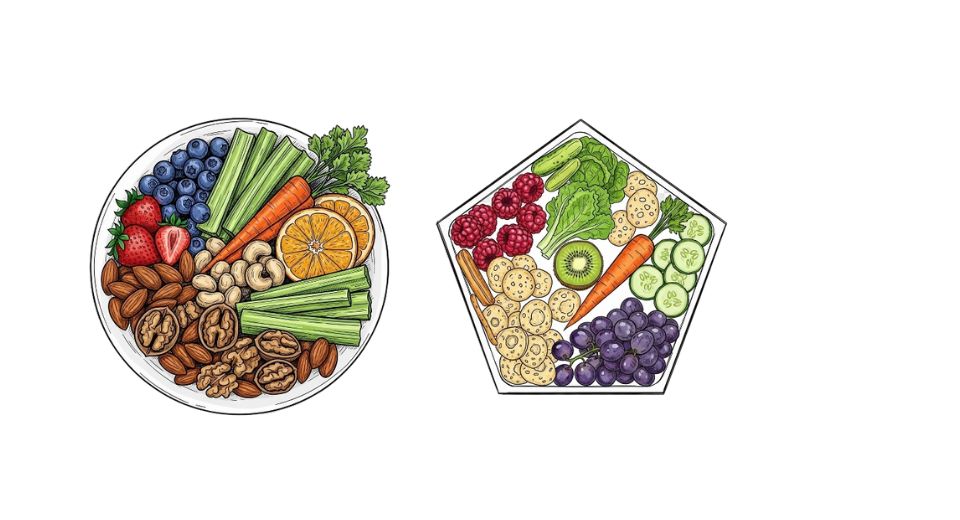
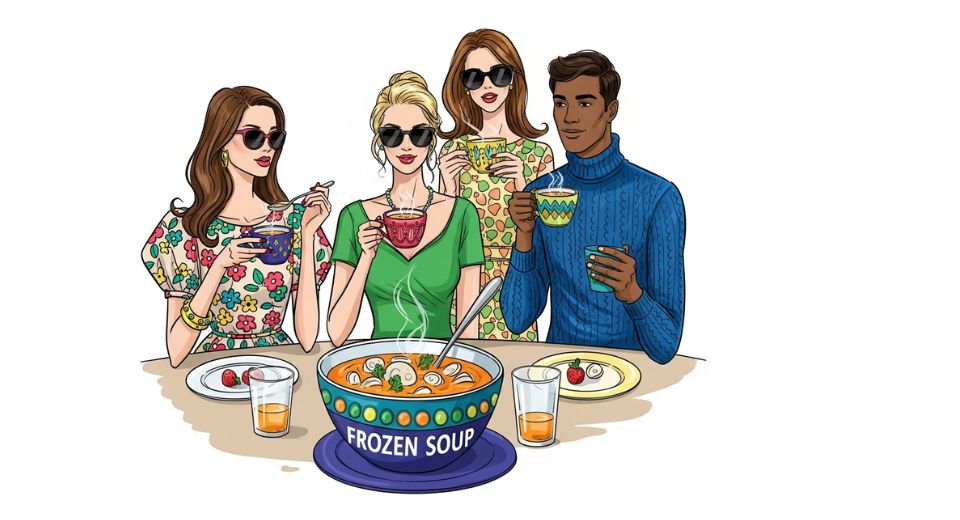
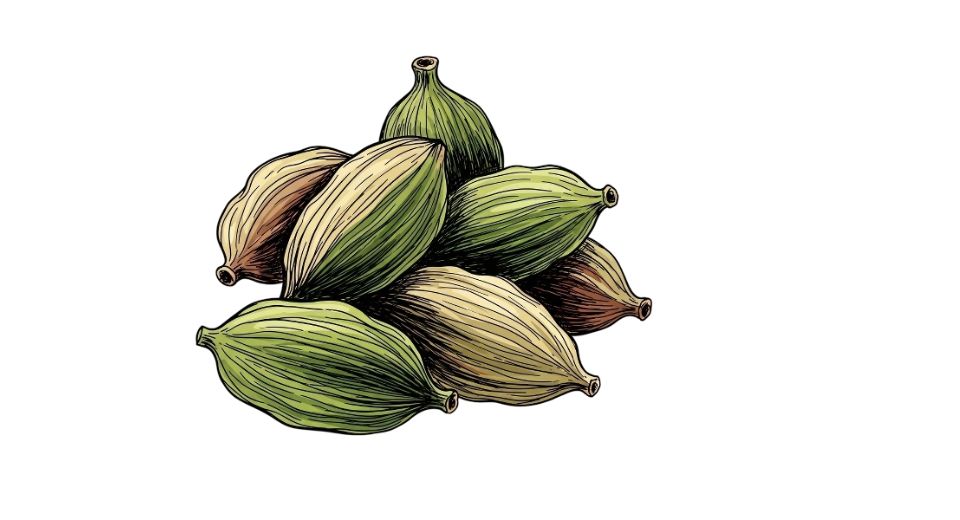
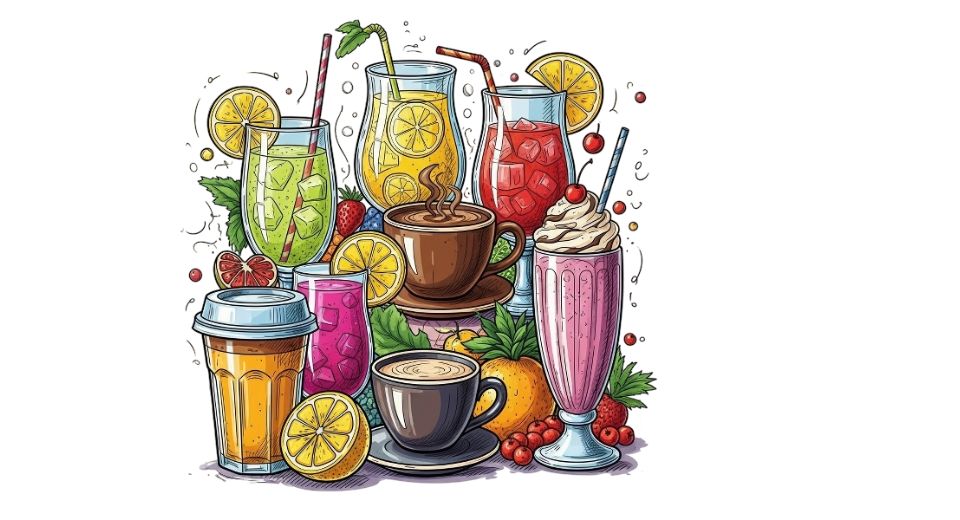

 US: +1 3023308252
US: +1 3023308252






